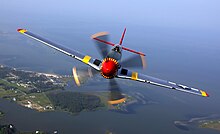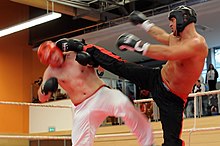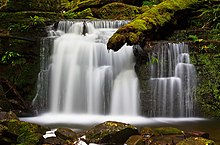Motion blur

As motion blur (in English-speaking countries as well, commonly known in the German-speaking motion blur called) is known in the photography a blur in images of moving objects that do not result from incorrect focus, aperture setting or other operating and setting errors of the photographer. It results solely from a perceptible movement of the subject during the exposure time and increases proportionally to the exposure time and the angular speed of the object relative to the camera.
This effect is often undesirable. Because photochemical emulsions in the 19th century were still relatively insensitive to light and required a long exposure time, people, animals or other mobile objects had to stand still for several seconds in order to be shown in focus.
The terms motion blur and other blurring are often confused. In the majority of shooting situations - such as macro photography - motion blur is undesirable, but in sports photography it is sometimes used to create dynamics in the image. In the case of mostly unwanted blurring , on the other hand, the entire image is blurred, this is only from a technical point of view a motion blur.
Pull along
The camera is pulled as synchronously as possible with a motif in its direction of movement. Its surroundings can become blurred if a correspondingly long exposure time is selected. However, this must be short enough to depict the desired main object in focus - without any blurring. Unless it is photographed with flash, whereby various effects (stroboscope, 2nd curtain, etc.) can be achieved with it.
A very well developed form of dragging in some systems is the tracking of long-term exposure astrophotographic recordings in order to compensate for the apparent movement of the celestial bodies due to the rotation of the earth.
Blur due to longer exposure times
With the camera held steady or with a tripod, the targeted use of motion blur is possible. An exposure time is chosen at which the desired picture elements appear blurred, while the rest of the main subject is shown in focus, e.g. B. in flowing traffic, fireworks or waterfalls. Sometimes a general blurring of the motif is also deliberately created .
Technical background
The main influence on the motion blur is the relative speed of the moving object in combination with the exposure time ; A shorter shutter speed can reduce motion blur, but it cannot be avoided in every case. Depending on the subject, the "freezing" of a movement is sometimes only possible with high-speed cameras or other techniques.
Synthetic motion blur
The effect of motion blur plays an important role in image processing . Often used to add a touch of movement to images. Therefore, in most modern image editing programs, there are synthetic motion blur effects that can be achieved through filters such as B. cause the blurring.
Motion blur is used in computer games and animation (computer-generated films) to make movements more realistic.
Web links
- Creating motion blur with Photoshop (instructional video)




